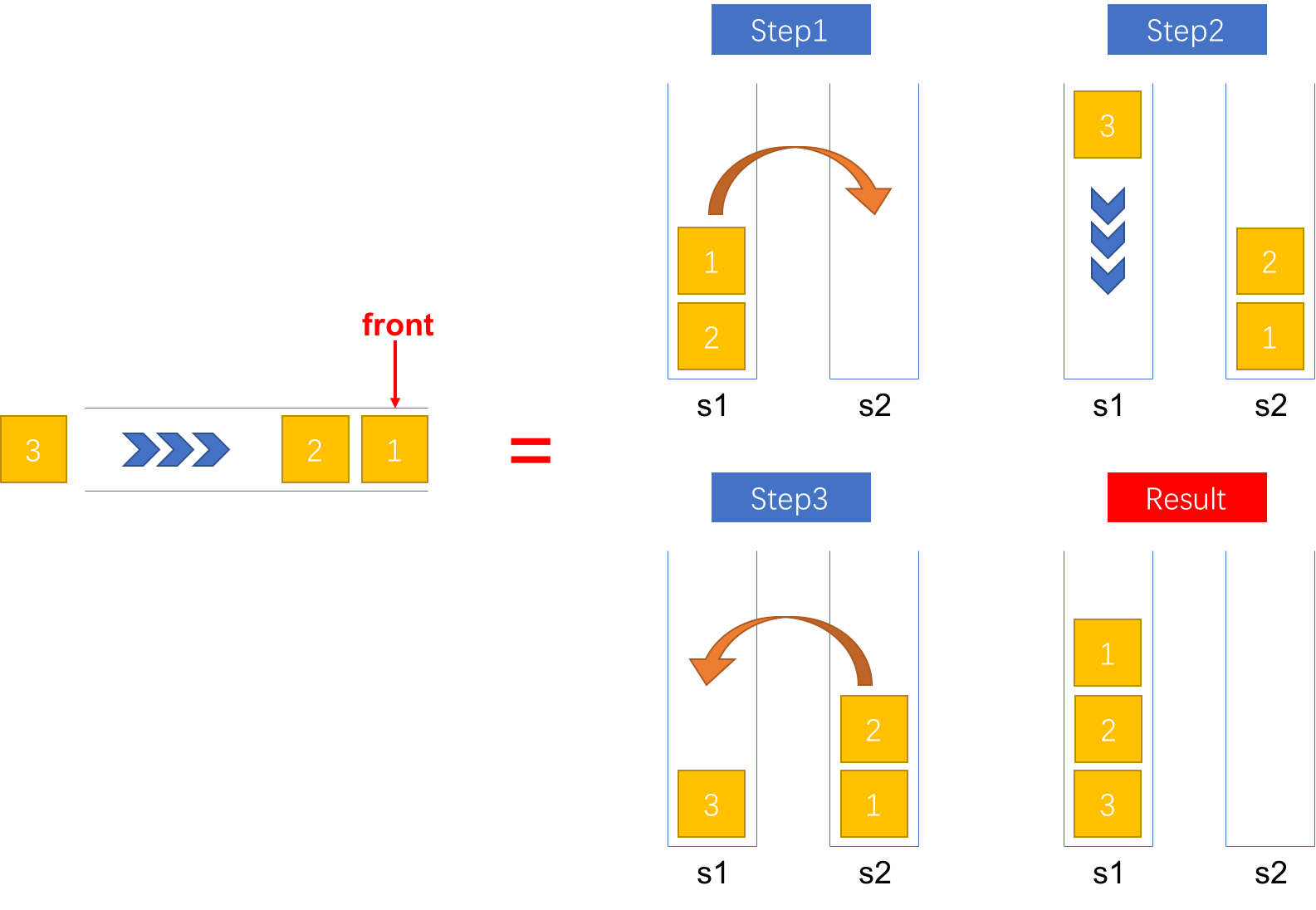更多 LeetCode 题解笔记可以访问我的 github。
描述使用栈实现队列的下列操作:
push(x) -- 将一个元素放入队列的尾部。
pop() -- 从队列首部移除元素。
peek() -- 返回队列首部的元素。
empty() -- 返回队列是否为空。
示例:
MyQueue queue = new MyQueue(); queue.push(1); queue.push(2); queue.peek(); // 返回 1 queue.pop(); // 返回 1 queue.empty(); // 返回 false说明:
你只能使用标准的栈操作 -- 也就是只有 push to top, peek/pop from top, size, 和 is empty 操作是合法的。
你所使用的语言也许不支持栈。你可以使用 list 或者 deque(双端队列)来模拟一个栈,只要是标准的栈操作即可。
假设所有操作都是有效的 (例如,一个空的队列不会调用 pop 或者 peek 操作)。
解法一:在一个栈中维持所有元素的出队顺序 思路队列是一种先入先出(first in first out, FIFO)的数据结构,而栈是一种后入先出(last in first out, LIFO)的数据结构。因此,如果要使用栈来达到队列的效果,即用有后入先出性质的数据结构来实现先入先出的效果,需要借用两个栈来改变元素的出队顺序。当然,借用两个栈来实现队列也有不同的实现方式,这一节介绍第一种实现方式,在下一小节介绍第二种方式。
第一种方式是在一个栈中维持所有元素的出队顺序,即所有的元素在入队操作完成后只会保存在一个栈中,且其出栈的顺序和出队的顺序是一致的。下面对入队、出队等操作的底层实现分别进行讲解。
入队(push)为了实现出栈顺序和出队顺序是一致的,入栈时必须将新的元素压入栈底。为了实现这种效果,在入队时,首先将栈1(假设栈1中保存所有的元素)中所有的元素弹出并压入栈2中,接着将新的元素压入栈1中,最后再将栈2中的所有弹出并压入栈1中。详细的步骤如图1所示。

图1:将一个元素入队
代码(Java)实现如下。
public void push(int x) { // 将栈1中的所有元素弹出并压入栈2中 while (!s1.isEmpty()) { s2.push(s1.pop()); } // 将新的元素压入栈1 s1.push(x); // 将栈2的所有元素弹出并压入栈1 while (!s2.isEmpty()) { s1.push(s2.pop()); } }复杂度分析如下:
时间复杂度:\(O(n)\),其中 \(n\) 表示入队时队列元素的数目,即栈1中元素的数目。入队时,栈1中的元素需要进行出栈和入栈两次,需要 \(4n\) 次操作,再加上新的元素的一次入栈操作,总的操作次数为 \(4n + 1\) 次。由于栈的入栈和出栈的时间复杂度是 \(O(1)\) 的,因此,入队的时间复杂度是 \(O(n)\) 的
空间复杂度:\(O(n)\)
出队(pop)出队操作比较简单,由于栈1中元素的出栈顺序和队列的出队顺序一致,因此,只需要弹出栈顶元素即可完成出队操作。
public int pop() { if (s1.isEmpty()) { throw new IllegalArgumentException("[ERROR] The queue is empty!"); } return s1.pop(); }复杂度分析如下:
时间复杂度:\(O(1)\)
空间复杂度:\(O(1)\)
查看队首(peek)与出队操作类似,只需要查看栈1栈顶的元素即可完成查看队首的操作。
public int peek() { if (s1.isEmpty()) { throw new IllegalArgumentException("[ERROR] The queue is empty!"); } return s1.peek(); }复杂度分析如下:
时间复杂度:\(O(1)\)
空间复杂度:\(O(1)\)
是否为空(empty)由于栈1中保存队列的所有元素,因此只需要判断栈1是否为空即可知道队列是否为空。
public boolean empty() { return s1.isEmpty(); }复杂度分析如下:
时间复杂度:\(O(1)\)
空间复杂度:\(O(1)\)
Java 实现 class MyQueue { private Stack<Integer> s1; private Stack<Integer> s2; /** Initialize your data structure here. */ public MyQueue() { s1 = new Stack<>(); s2 = new Stack<>(); } /** Push element x to the back of queue. */ public void push(int x) { while (!s1.isEmpty()) { s2.push(s1.pop()); } s1.push(x); while (!s2.isEmpty()) { s1.push(s2.pop()); } } /** Removes the element from in front of queue and returns that element. */ public int pop() { if (s1.isEmpty()) { throw new IllegalArgumentException("[ERROR] The queue is empty!"); } return s1.pop(); } /** Get the front element. */ public int peek() { if (s1.isEmpty()) { throw new IllegalArgumentException("[ERROR] The queue is empty!"); } return s1.peek(); } /** Returns whether the queue is empty. */ public boolean empty() { return s1.isEmpty(); } } Python 实现 class MyQueue: def __init__(self): """ Initialize your data structure here. """ self._s1, self._s2 = [], [] def push(self, x): """ Push element x to the back of queue. :type x: int :rtype: void """ while self._s1: self._s2.append(self._s1.pop()) self._s1.append(x) while self._s2: self._s1.append(self._s2.pop()) def pop(self): """ Removes the element from in front of queue and returns that element. :rtype: int """ return self._s1.pop() def peek(self): """ Get the front element. :rtype: int """ return self._s1[-1] def empty(self): """ Returns whether the queue is empty. :rtype: bool """ return not self._s1 解法二:一个栈入,一个栈出 思路
